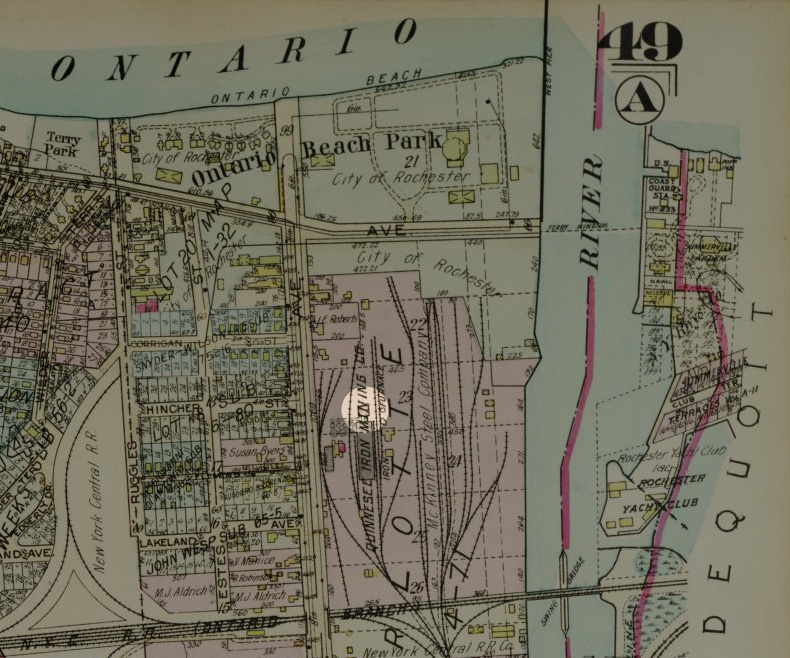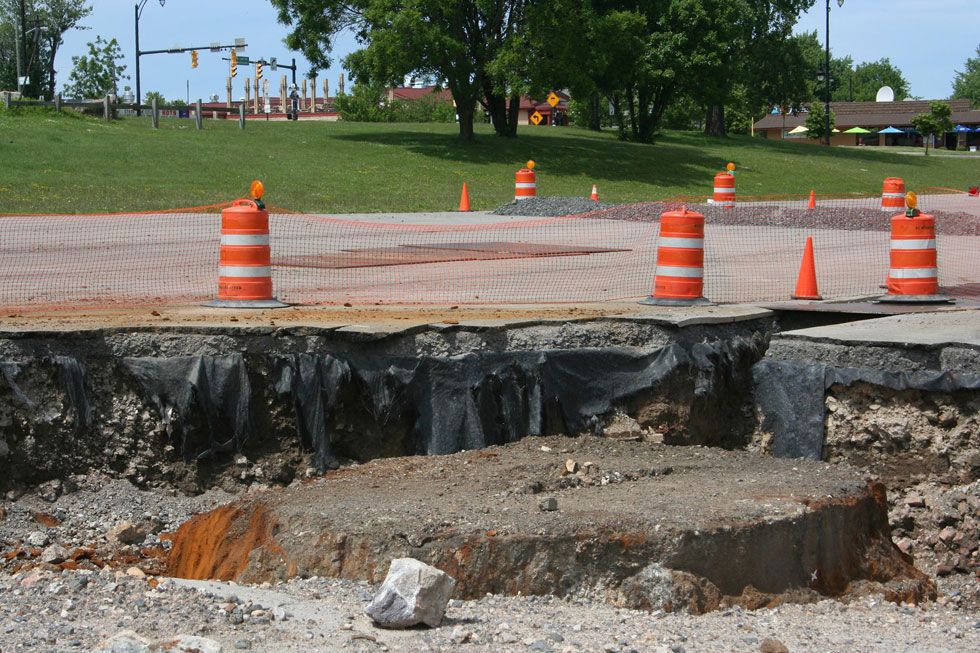This article was scraped from Rochester Subway. This is a blog about Rochester history and urbanism has not been published since 2017. The current owners are now publishing link spam which made me want to preserve this history.. The original article was published June 17, 2013 and can be found here.
![Did an asteroid land in the parking lot at Ontario Beach? Not quite. This 100 ton hunk of slag is a remnant from an old steel mill. [PHOTO: Fred Amato]](https://senseofplace.dev/content/images/photos/slag-button-charlotte-beach-rochester-01.jpg)
David DiPonzio, a firefighter with the Lake Shore Fire District in Greece, sent me these photos (taken by friend Fred Amato) of a strange-looking crater in the middle of the parking lot

at Ontario Beach Park. An asteroid? Uh, not quite. This may be the most interesting archeological find since RGRTA dug up the RKO Palace . That big rock you see in the center of the crater is actually a giant hunk of slag - left over from the iron or steel mill that once operated here...
![Referred to as a 'button,' this is the byproduct of the iron-making process. The City is looking for a way to move it. [PHOTO: Fred Amato]](https://senseofplace.dev/content/images/photos/slag-button-charlotte-beach-rochester-02.jpg)
City of Rochester engineer, Jim McIntosh tells me that Rochester Gas & Electric was digging up the parking lot in order to move some electrical lines (in preparation for the construction of Rochester's new marina) when they hit a literal bump in the road. "It's called a 'button'...leftover iron and other heavy metals and sands," Jim says. The byproduct of the iron-making process.

This 1926 plat map shows this to be the site of Quinnesee Iron Mining Co. The highlighted area is where the slag was unearthed and this must have been the location of a blast furnace

.
Now, I know nothing about the iron or steel-making process so I turn to my good friend, Wikipedia which explains how fuel, iron ore and limestone were loaded into the top of the blast furnace. As the mixture moved downward it mixed with air and oxygen from the bottom of the furnace. The result was molten metal, and slag (the byproduct, a.k.a. "the button"). The slag

is mostly the limestone or dolomite which has absorbed phosphate from the iron ore.
![Approximate location of the slag 'button'. [IMAGE: Google]](https://senseofplace.dev/content/images/photos/slag-button-charlotte-beach-rochester-03.jpg)
The button's weight is estimated at around 200,000lbs (100 TONS!). McIntosh says the City has solicited the advice of an expert who has worked with these on the Bethlehem Steel site

in Buffalo. "We need to relocate it so that RG&E can finish their electrical work prior to Marina construction. How to move a 100 ton mass is something we don't deal with often."
That Wikipedia article may indicate one possible solution... Fertilizer! "Because of the slowly released phosphate content, and because of its liming effect, [slag] is valued as fertilizer in gardens and farms in steelmaking areas."
So let's get some farmers up to Charlotte and let them chip away at it. Problem solved! Jim, I'll send you a bill
UPDATE: an earlier version of this article gave credit to David DiPonzio for taking the photos. They were actually taken by Fred Amato. Sorry Fred!
ANOTHER UPDATE: LaBella Associates, the engineering firm working with the City on this, may have found photos of the actual iron facility. The first image is the blast furnace. See the rivets on the steel ring down at the base? Engineers think they have found that steel ring in the parking lot. It goes down into the ground about 5 feet and will probably have to be dug out...
![Quinnesee Iron Mining facility at Charlotte. [IMAGE VIA: LaBella Associates]](https://senseofplace.dev/content/images/photos/quinnesee-iron-mining-company-rochester-02.jpg)
![Quinnesee Iron Mining facility at Charlotte. [IMAGE VIA: LaBella Associates]](https://senseofplace.dev/content/images/photos/quinnesee-iron-mining-company-rochester-01.jpg)


